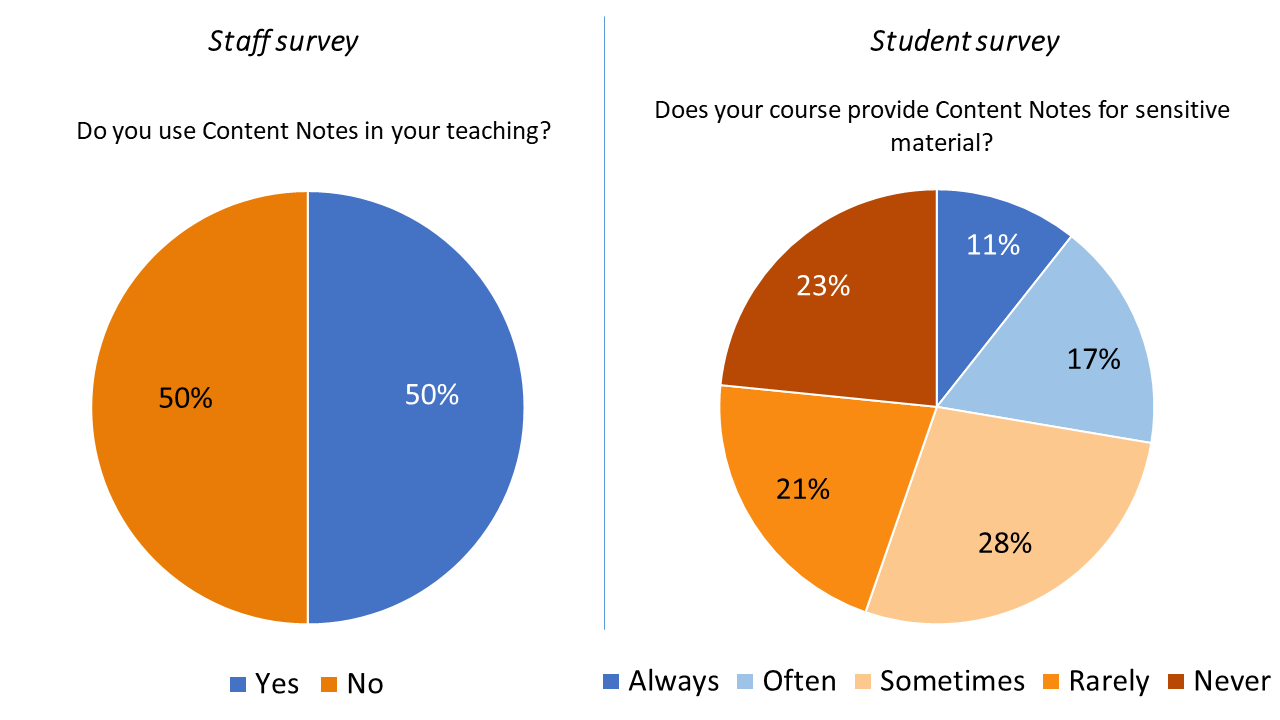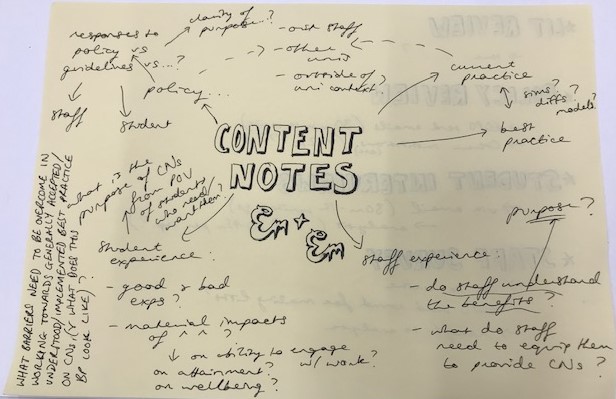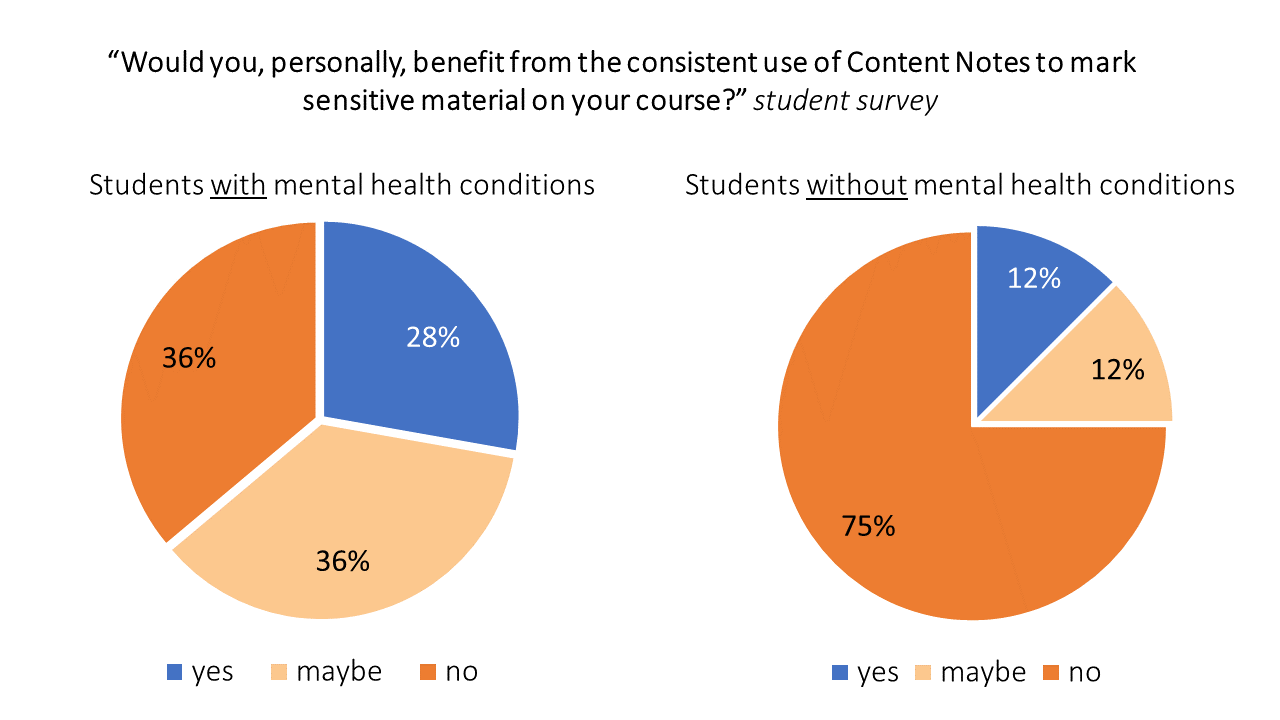Student Project: Content Notes
The University's Access and Participation Plan: Participatory Action Research (APP PAR) Project was launched at the beginning of the 2019-20 academic year in response to the Office for Students' focus on attainment gaps. This project, involving CCTL and 18 student co-researchers, aims to explore specific barriers and practices that impact the educational experience and attainment of black British students and disabled students with mental health conditions, the two groups with the widest attainment gaps at Cambridge.
Over the next few editions of the newsletter we will be hearing directly from the students on the projects they conceived and the research they carred out. This month Emma and Emrys are discussing their project on Content Notes.
Supporting student learning with Content Notes
We joined a team of student and staff co-researchers to undertake participatory action research for the University Access and Participation Plan. The goal of the overall APP PAR Project was to understand and begin to resolve disparities in the educational experiences of specific groups, and explore factors influencing 'attainment' or 'equity' gaps (factors can range from social to structural, and present barriers to specific groups).
The APP PAR Project co-researchers worked collaboratively to identify reasons for the attainment gaps and to develop small-group research projects for further investigation. We decided to focus on Content Notes: a form of warning about the discussion of certain material in written or verbal content, particularly useful to warn individuals with mental health conditions such as post-traumatic stress disorder (PTSD) about material relating to themes of trauma.
Rationale
Content Notes are a subject of lively scholarly debate: critics such as Lukianoff & Haidt, and Jack Halberstam, assert that those who ask for Content Notes are "spoiled, overparented and overly invested in their own trauma" (Halberstam, 2017).
These views are strongly challenged by other researchers in the field. For example, Angela Carter argues that much of the confusion regarding Content Notes relates to their perceived function, and that they are in fact useful tools to prevent individuals from "mentally and physically re-experienc[ing] a past trauma" (2019). Sofia Fenner argues similarly that critics of Content Notes "fail to recognize the distinct features of posttraumatic stress as a form of mental illness" (2018). She also presents the important point that rather than encouraging academic disengagement, Content Notes enable students with PTSD to get "as close to valuable material as they can" (2018).

In the context of the University of Cambridge, despite published CUSU guidance on Content Notes, advising how they may be used in practice as a reasonable adjustment for disabled students under the Equality Act, Content Note provision seems inconsistent in practice. We therefore decided to conduct research to answer the following questions:
- To what extent were existing guidelines being followed by academic / teaching staff?
- What was the effect on students' wellbeing and ability to engage with academic material, where Content Notes were or were not being used?
- What barriers were preventing consistent practice regarding Content Notes?
Methods
To answer these questions we used three routes of data collection:
- Survey for disabled students
This was distributed by the DRC and asked students whether they had experienced use of Content Notes in their course, whether such provision did or would have benefited them or not, and whether they agreed with the use of Content Notes at the University. - In-depth email interviews
This was sent to all the student co-researchers, across both strands of the Access and Participation Plan research project. It asked for more detailed responses about students' experiences with provision of Content Notes. - Survey for teaching staff
This went to staff at three University faculties. It aimed to gauge current staff practices regarding Content Notes, and to explore attitudes towards - and practical barriers to - Content Note provision from the staff perspective.

This multi-strand approach aimed to integrate the perspectives of staff and students, in the hope of resolving some of the conflict regarding Content Notes and encouraging a consistent best practice across the University. The APP PAR Project and the methods used by this particular small-group project were reviewed by the Cambridge Higher Education Studies Research Ethics Committee.
Findings: student reponses
Students describing positive experiences consistently emphasised that the provision of Content Notes had enabled them to "best prepare [themselves] to engage" with content that might otherwise have proved triggering or in some way difficult. Examples of such preparations included asking a friend to accompany them to a lecture, listening to a recorded lecture in their own room rather than in a crowded lecture theatre, and checking through summaries of texts before reading the texts themselves.
Some respondents indicated that simply being provided with a Content Note made a significant difference to their preparedness to engage with triggering material:
"I would have been extremely triggered by reading the text without any warning, but as I was given the warning, I was able to read the text in a prepared frame of mind."
As well as the consistent implication that improved engagement led to a better academic performance, one student made this explicit:
"My best CN'd [Content Noted] module at undergrad was by far my highest exam mark."
A frequently reported positive impact of Content Notes was that respondents felt "more comfortable" and "more engaged" in academic discussion, due to a sense of validation and respect, even where material was not personally triggering for them.
"Content Notes give a topic validation / kudos - i.e. 'we respect that this may bring you trauma'."
"It lets me know that [teachers] are beginning from a place of good intentions, and that goes a long way."
"I was reassured that if I did need to leave or disengage at any point, the lecturer / class leader would be understanding."
One respondent also noted that the provision of a Content Note can be a thought-provoking reminder to all students that the issues being academically discussed are real-world issues that may have affected their peers.

Negative experiences in the absence of Content Notes were more numerous, and where respondents described encountering triggering material they invariably reported a tangible negative impact upon their ability to engage and focus academically, as well as on their wellbeing. Reported trigger responses varied from "zoning out" and "dissociating" in class to experiencing "flashbacks", which one respondent described as:
"reliving the traumatic event to the extent that [I] feel like it is happening again... I often look like I am having a seizure... behaving as if I was experiencing the most horrifying events of my life."
This respondent described experiencing such a flashback in response to a discussion without warning of child abuse in a lecture, an experience which they underlined was not only "incredibly distressing" but also "disruptive to the teaching of the lecture itself". Multiple respondents also said they had lost contact time, not only due to the immediate impact of a trigger response, but also to avoiding certain lecture series as a result of persistently triggering material, or the unknown risk of such material without Content Notes.
Findings: staff responses
Staff responses represented a wide spectrum of approaches, with half of respondents reporting that they did use Content Notes in some form in their teaching, and half reporting that they did not.
Staff who used Content Notes explained their reasoning for doing so with a range of responses, some simply mentioning "student demand" (and one or two mentions of "faculty policy"), but a majority indicating that they wished to avoid subjecting students to "distressing" or "disturbing" content without warning. Some respondents made explicit reference to potential trauma:
"I try to recognise that people may have had varied and perhaps traumatic experiences in their lives."
Staff who did not use Content Notes mostly indicated that they did not feel the content they taught to be potentially triggering. Some raised logistical barriers such as time constraints, not having seen examples of Content Notes, and being unsure which topics might benefit from Content Notes. The remainder of justifications were idealogical, arguing that students "are adults" (a repeated refrain) who "should not be wrapped in cotton wool" or treated as "fragile".
In the final open question to staff, one respondent elaborated on this point, arguing that students should be "exposed" to "challenging" material and thereby made more "resilient", and that Content Notes threaten "intellectual freedom" and are:
"a passing fad normally only championed by virtue-signalling self-promoters..."
Other respondents, ranging from sceptical to supportive, raised questions concerning how certain material should be determined 'sensitive', as well as constructive ideas about practical pedagogical changes. Some also pre-empted the "intellectual freedom" argument:
"I include content notes because I discuss difficult topics... Better framing of lecture topics allows me to go deeper into certain topics and discuss them more honestly with students while also recognising that students (and I) have had varied life experiences that contribute to our understanding of these topics."
Next steps
The disabled students' survey indicated wide support for Content Notes among students, and the qualitative data illustrate why and how this would be the case, from ethical reasons to academically practical reasons such as allowing individuals to prepare and engage. This provides a strong imperative for the University to take concrete steps to support staff in providing Content Notes for teaching material which relates to common traumas.
We are extremely pleased to have been awarded funding from the University Diversity Fund to oversee the creation of guidance and models for the implementation of Content Notes, including working with faculties to ensure that this guidance attends to the particular needs and contexts of different course materials and pedagogical models.
Authors
Emrys Travis

Emrys Travis is a Master's student in Comparative Literatures & Cultures at St John's College, and was Disabled Students' Officer 2018-19.
Emma Carey

Emma Carey is a PhD student at Newnham College, and is studying the effects of psychological trauma on mental health.
References
Carter, A. (2015) Teaching with Trauma: Disability Pedagogy, Feminism, and the Trigger Warnings Debate. Disability Studies Quarterly, 35(2).
Fenner, S. (2018) Not So Scary: Using and Defusing Content Warnings in the Classroom. Journal of Political Science Education, 14(1), 86-96.
Halberstam, J. (2017) Trigger Happy: From Content Warning to Censorship. Signs: Journal of Women in Culture and Society, 42(2), 535-542.
Lukianoff, G. & Haidt, G. (2015) How Trigger Warnings are Hurting Mental Health on Campus. The Atlantic. Accessed: 27 February 2020.
Cambridge Teaching & Learning Newsletter vol. 1 (issue 5) May 2020
